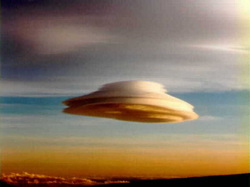
Electrical charges within storm clouds create lightning that is fascinating and scary, but clouds that do not produce lightning are also fascinating although taken pretty much for granted. I recently saw this photo of a Lenticular cloud. They sometimes look like discs and have been mistaken for flyng saucer-type UFO's. How amazing is that?
What we call a cloud here on Earth is basically formed when invisible water vapor forms into liquid droplets or solid ice crystals, both visible forms of water molecules suspended in the atmosphere. Cloud droplets are very small, perhaps a thousand times smaller than a raindrop. The highest clouds are called Cirrus clouds because cirrus, Latin for curl, refers to the thin, feathery look of white clouds with long streamers that stretch across the sky high above the Earth. Those greyish clouds that cover all or most of the sky are named Stratus, Latin for strewn, because they lie across the sky like a sheet on a "cloudy" day. Fog is also a Stratus cloud although it is very close to the ground. What about those small, puffy cotton-ball clouds that float leisurely across the sky? Those are Cumulus cloudlets, Latin for heap, because they can increase in size to become the Cumulonimbus clouds up to six miles high that produce fierce thunder storms holding up to half a million tons of water. Since according to NASA, "clouds have an enormous influrence on Earth's energy balance, climate, and weather," we should pay more attention to them.
What we call a cloud here on Earth is basically formed when invisible water vapor forms into liquid droplets or solid ice crystals, both visible forms of water molecules suspended in the atmosphere. Cloud droplets are very small, perhaps a thousand times smaller than a raindrop. The highest clouds are called Cirrus clouds because cirrus, Latin for curl, refers to the thin, feathery look of white clouds with long streamers that stretch across the sky high above the Earth. Those greyish clouds that cover all or most of the sky are named Stratus, Latin for strewn, because they lie across the sky like a sheet on a "cloudy" day. Fog is also a Stratus cloud although it is very close to the ground. What about those small, puffy cotton-ball clouds that float leisurely across the sky? Those are Cumulus cloudlets, Latin for heap, because they can increase in size to become the Cumulonimbus clouds up to six miles high that produce fierce thunder storms holding up to half a million tons of water. Since according to NASA, "clouds have an enormous influrence on Earth's energy balance, climate, and weather," we should pay more attention to them.
 RSS Feed
RSS Feed